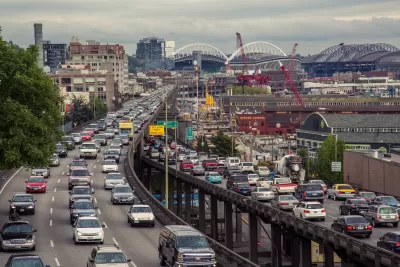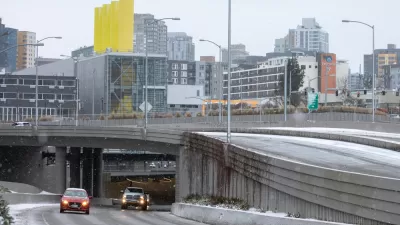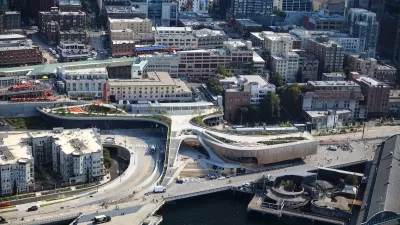Seattle recently closed the Alaskan Way Viaduct, but the predicted traffic chaos hasn’t ensued.

Joe Cortright takes a closer look at the effects of the closure of Seattle's Alaskan Way Viaduct, a roadway that handled almost 100,000 vehicle trips a day. He finds that the peak-hour traffic patterns two days in do not look that much different than typical days in the past.
In fact, some surrounding roadways look less congested — the result, says Cortright, of drivers changing or postponing trips as they adjust to the new street network:
It’s a corollary of induced demand: when we build new capacity in urban roadways, traffic grows quickly to fill it, resulting in more travel and continuing traffic jams. What we have here is “reduced demand” – when we cut the supply of urban road space, traffic volumes fall.
Cortright notes that the phenomenon of Carmageddon predictions that never play out has happened before in other cities with major road projects, including Los Angeles, Atlanta, and Minneapolis.
He adds that what happens in Seattle in coming weeks could provide important lessons about the perceived impacts of adjusting roadway capacity. "For example, this ought to be a signal that road diets, which have been shown to greatly improve safety and encourage walking and cycling, don’t have anything approaching the kinds of adverse effects on travel that highway engineers usually predict."
FULL STORY: Why Carmaggedon never comes (Seattle edition)

Maui's Vacation Rental Debate Turns Ugly
Verbal attacks, misinformation campaigns and fistfights plague a high-stakes debate to convert thousands of vacation rentals into long-term housing.

Planetizen Federal Action Tracker
A weekly monitor of how Trump’s orders and actions are impacting planners and planning in America.

In Urban Planning, AI Prompting Could be the New Design Thinking
Creativity has long been key to great urban design. What if we see AI as our new creative partner?

Massachusetts Budget Helps Close MBTA Budget Gap
The budget signed by Gov. Maura Healey includes $470 million in MBTA funding for the next fiscal year.

Milwaukee Launches Vision Zero Plan
Seven years after the city signed its Complete Streets Policy, the city is doubling down on its efforts to eliminate traffic deaths.

Portland Raises Parking Fees to Pay for Street Maintenance
The city is struggling to bridge a massive budget gap at the Bureau of Transportation, which largely depleted its reserves during the Civd-19 pandemic.
Urban Design for Planners 1: Software Tools
This six-course series explores essential urban design concepts using open source software and equips planners with the tools they need to participate fully in the urban design process.
Planning for Universal Design
Learn the tools for implementing Universal Design in planning regulations.
Gallatin County Department of Planning & Community Development
Heyer Gruel & Associates PA
JM Goldson LLC
City of Camden Redevelopment Agency
City of Astoria
Transportation Research & Education Center (TREC) at Portland State University
Jefferson Parish Government
Camden Redevelopment Agency
City of Claremont





























